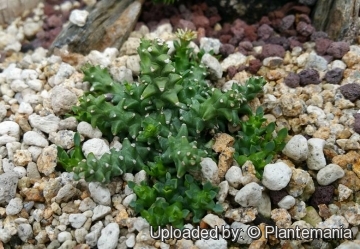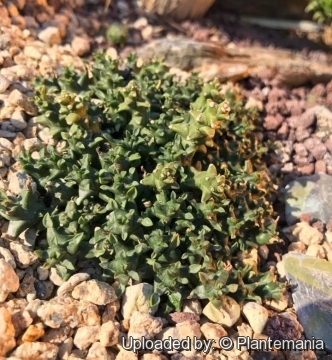
Euphorbia planiceps Photo by: © Plantemania
Origin and Habitat: North-Eastern and Northern Cape: Griqualand West: Hay Div., Farm near Griquatown, near Banks-fontein.
Habitat and ecology: Kuruman Mountain Bushveld. Euphorbia planiceps is an edaphic specialists species, that occur only on rocky calcareous outcrops, which includes calcrete, dolomite and limestone. It grows together with other dwarf succulent plants such as Prepodesma orpeniiSN|768]]SN|768]], Euphorbia wilmaniae and Avonia albissimaSN|27288]]SN|27288]].
Synonyms:
Description: Euphorbia planicepsSN|33622]]SN|33622]] is a low, succulent shrublet developing from a underground caudex (thickened stem) that is a continuation of the tuberous main root, divided below into carrot- like or longer roots. On the head and at the sides the there are a great number of branches which re-divide, forming a dense congested mat (up to 300 mm in diameter) which appears flat on the soil surface. This 'flat head' is due to the continual con-traction of the branches downwards, a feature which controls water loss in the arid areas in which it lives. Unlike the related species here it does not develop rhizomes. The plant is is spineless but the peduncles however persist for a year or longer, and are 1.5-2.5 mm long. Its remarkable flowers (cyathia), possess at the outer edge of the glands 3-4, conspicuous, teeth-like processes commonly referred as fingers.
Roots: Tuberous, merging into stem.
Stem: Densely branched below ground, with branchlets just emerging above. Branchlets to 2.5 cm long and 1 cm in diameter, with prominent tubercles to 5 mm long, in spiral series.
Cyathia: Solitary; peduncles to 2.5 mm, sometimes persisting. Cyathium approx.1 cm in diameter, with two-lipped glands, the outer lip with 3-4 teeth-like processes about 3-3.5 mm long, edges more or less in-rolled.
Fruits. Obscurely lobed, about 8 mm in diameter.
Bibliography: Major references and further lectures
1) Hermann Jacobsen “Abromeitiella to Euphorbia” Blandford Press, 1960
2) Doreen Court “Succulent Flora of Southern Africa” CRC Press, 01 June 2000
3) Urs Eggli “Illustrated Handbook of Succulent Plants: Dicotyledons” Springer Science & Business Media, 2002
4) Pjotr Lawant & Rikus van Veldhuisen “A monograph about some long existing taxonomic mysteries …” Euphorbia World 10(1), April 2014 https://www.euphorbia-international.org/add_texts/A%20monograph%20about%20some%20long%20existing%20taxonomic%20mysteries.pdf
5) http://www.sahra.org.za/sahris/sites/default/files/additionaldocs/9-2-037-0001%20vol%2034%20part%202_EIA%20report%20part4.pdf
6) AW Frisby “Redefining the Griqualand West Centre of Endemism” Dissertation submitted in fulfilment of the requirements for the degree Magister Scientiae in Botany at the Potchefstroom Campus of the North-West University May 2016 https://dspace.nwu.ac.za/bitstream/handle/10394/18035/Frisby_AW_2016.pdf?sequence=1&isAllowed=y
7) Simon Todd “Flora, Fauna & Avifauna” Specialist EIA Report, January 2015 http://www.cape-eaprac.co.za/projects/TSA309%20Re%20Capital%2010%20Solar/FEIR/D1%20Flora%20Fauna%20Avifauna%20EIA%20Report.pdf
 Euphorbia planiceps Photo by: © Plantemania
Euphorbia planiceps Photo by: © Plantemania Euphorbia planiceps Photo by: © Plantemania
Euphorbia planiceps Photo by: © Plantemania Euphorbia planiceps Photo by: © Plantemania
Euphorbia planiceps Photo by: © PlantemaniaSend a photo of this plant.The gallery now contains thousands of pictures, however it is possible to do even more. We are, of course, seeking photos of species not yet shown in the gallery but not only that, we are also looking for better pictures than those already present.
Read More... Cultivation and Propagation: It is an easy to grow succulent plant for pot culture that will form a small caudiciform stem and make a fascinating specimen.
Growing rate: It is a relatively fast growing species that will make large clumps given the best conditions.
Soil: It grows well in a very draining mineral potting substrate, but it isn't picky about soil.
Watering: The area to which this plant is native receives rains in both winter and summer, so it can be watered moderately all year around (except in the coldest month of the winter, as it rots easily, especially if overly wet). During the summer they enjoy average feeding and watering.
Hardiness: When dormant in winter, keep it totally dry at or around 4°C, even though it seems to tolerate light frosts well. Mature healthy plants are tough and can also be grown out-of-doors where frost is not too severe, but when left out it is more sensitive to frost and need protection from rain.
Exposure: They do need a lot of light to keep their compact growth-form, but different clones vary in their tolerance of full sunshine. Sometimes, in really hot full sun all day long, a plant will bleach out a bit.
Maintenance: It can be grown in a pot or planted in the ground, but as it enlarges, especially if generously watered and fed, it becomes a messy, twisted mass of knobby branches that eventually may need to be cut back.
Traditional uses: It is used in some areas as an excellent fodder plant especially for cattle.
Propagation: It is propagated by seeds or cuttings (It branches enthusiastically, and offsets are readily available). If you remove an offset, remember to let it dry for a week or so, letting the wound heal (cuttings planted too soon easily rot before they can grow roots). It is better to wash the cut to remove the latex.














